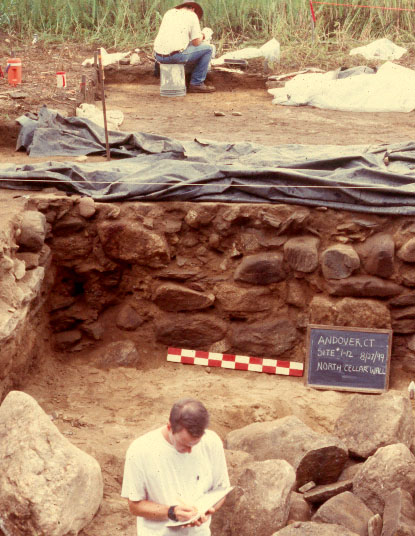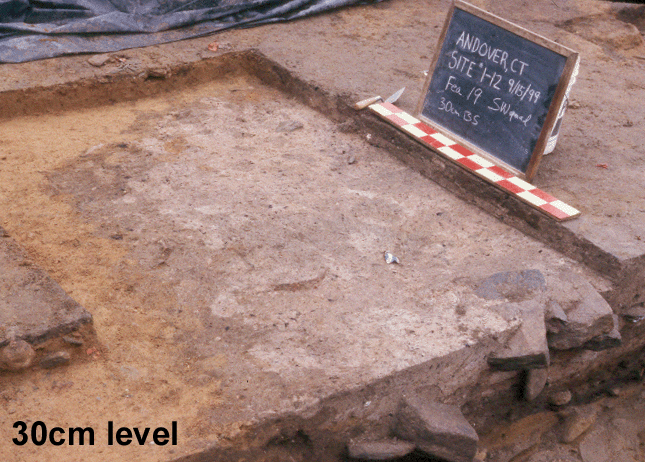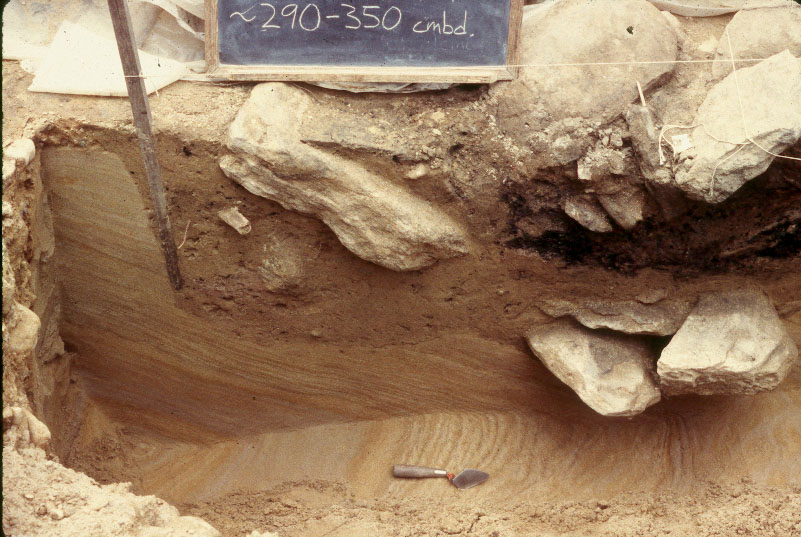
Map of the project area showing intersection improvements.

|
|
Map of the project area showing intersection improvements. |
The Ephraim Sprague House Site was discovered in the course of archaeological surveys that accompanied the Connecticut Department of Transportation's reconstruction of intersections on Route 6 just south of Andover Center. The highway-improvement project involved eliminating the intersection at each end of Merritt Valley Road and extending Lake Road through a cornfield to Route 6. In this way, the single intersection at Lake Road would take the place of the two discontinued Merritt Valley Road intersections.

|
|
A cornfield covered the site at the beginning of the project. |
Because the project used federal funding, it had to comply with the
National
Historic Preservation Act, which mandates identification and mitigation of impacts to
significant archaeological and historical resources. In accordance with the Act,
before any construction began,
the State Historic Preservation Office at the Connecticut Commission on Culture & Tourism
reviewed the project plans and determined that the project area possessed archaeological sensitivity,
recommending that a professional survey be conducted to
identify any possibly significant archaeological resources in the project area.

|
|
Archaeologists make meticulous field notes as they work to ensure that the entire site is recorded in great detail. |
The archaeological survey was conducted in phases. In Phase I, the reconnaissance phase, undertaken in 1997, twenty-four shovel test pits were placed within the projected route of the Lake Road extension. In addition to a number of Native-American lithic artifacts (mostly flakes from the manufacture of stone tools and projectile points), the Phase I test pits produced 127 historic-period artifacts, including fragments of glass, ceramic and metal objects, and kaolin pipes. Because of the relatively high yield of artifacts from just two dozen test pits, the site was given a number in the statewide archaeological database, Site 1-12, and a Phase II Intensive Archaeological Survey was recommended.
Phase II was designed to evaluate the significance of Site 1-12 using the eligibility criteria of the National Register of Historic Places, Criterion D of which recognizes properties that have yielded, or may be likely to yield, information important in prehistory or history. The Phase II work, performed the following year, consisted of 169 additional shovel test pits placed at 5-meter intervals, as well as three 1 x 1-meter excavation units. Nearly 3,000 additional historic-period artifacts were discovered, along with what appeared to be the edge of a buried foundation or cellar-hole wall. The Phase II artifact assemblage pointed to an early to mid-18th-century date. The site was determined to have excellent stratigraphic integrity, meaning that it had been relatively unaffected by modern ground-disturbing activities (only plowing had occurred, which just skimmed the top of the archaeological deposits). As part of the Phase II study, more intensive background research was undertaken. A compilation of a complete chain of title from the land records traced the property back to the first years of English settlement, when it was the homestead of Ephraim Sprague (1685-1754). Based upon these findings, it was recommended that Site 1-12 be considered eligible for listing on the National Register of Historic Places.
The Connecticut Department of Transportation evaluated alternatives to
impacting the site
but found that there was no realistic design that could avoid its destruction.
It was determined that the impacts to the site could only be mitigated by conducting a Phase III archaeological excavation,
also known as data recovery.
Although the site itself was destroyed by the archaeological data recovery,
the essence of the site--its historical information--was preserved.
More than 200,000 artifacts and ecofacts were recovered, and two cellars,
food-storage pits, and two hearths were exposed. Data recovery also produced hundreds of photographs, a
site plan,
and drawings, as well as a
database that allowed
statistical analysis of artifact distributions across the site.
This information permits the reconstruction of the architecture of Ephraim Sprague's dwelling and the lifeways of
his household.

|
In the Data Recovery phase, the site was excavated in a series of one-meter (39") squares. The soil was removed in 10 to 20-cm (4-8") levels and screened through 1/8-inch mesh so as to recover very small artifacts and ecofacts. Hundreds of soil samples were taken from the site to the archaeological laboratory, where a water-flotation procedure allowed the recovery of even smaller items, such as seeds. To the left, a large ash feature in the center of the site, interpreted as the location of a cooking hearth, is shown alternately as excavated to the the 30cm level and to the 50cm level. |
|
In addition to recovering artifacts and ecofacts, the Data Recovery documented numerous features, such as this food-storage pit dug into the sandy floor of the south cellar. |

|